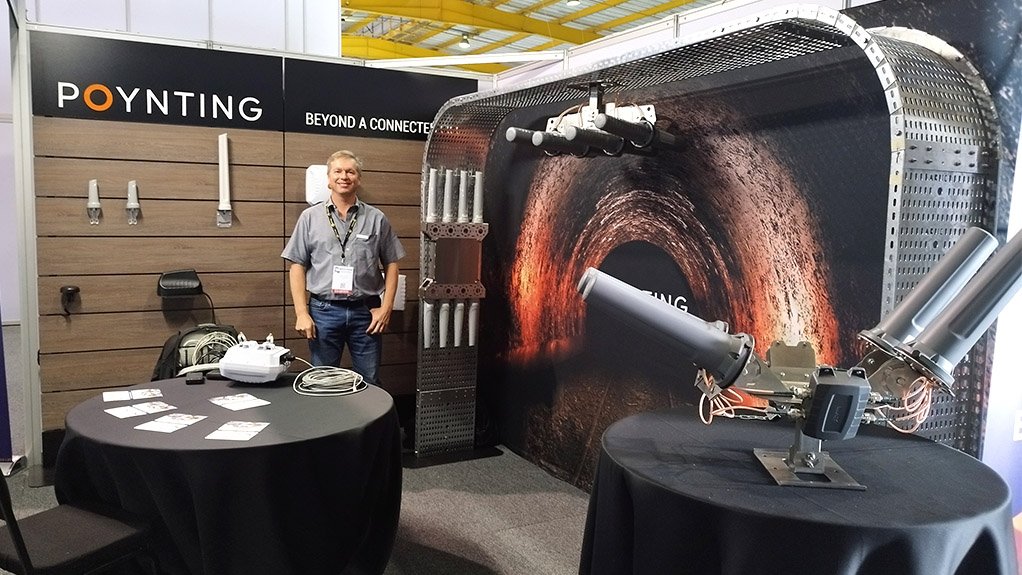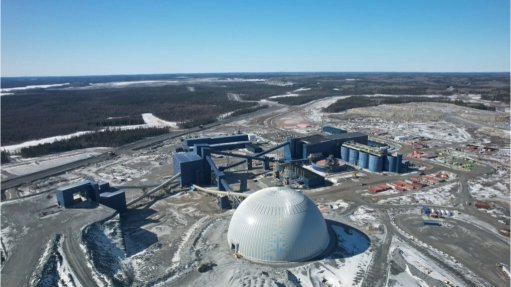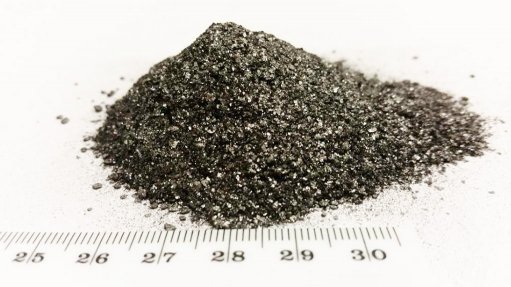Specialised antennas ensure connectivity in mine tunnels
Telecommunications equipment supplier Poynting Antennas offers locally designed antennas to ensure robust connectivity in various industries, including openpit and underground mining. The company prioritises quality and performance in the design and manufacture of antennas that are suitable for industrial grade as well as higher end consumer and commercial grade deployments.
Established in South Africa in 2001, the company also has offices in Europe and North America, with more than 70 distributors in Europe, Africa, North America and Asia-Pacific.
Its antennas are suited to the mining, marine, agriculture, transport and fixed wireless industries, besides others.
Poynting Antennas’ range of mining and tunnel-specific antennas include the HELI Series, Omni-700 Series and the smaller Puck Series. The Poynting Rhyno antenna – Omni-700 series – and the MinePOYNT – HELI series – antennas are specifically designed for the mining industry, while the Puck Series can be used in numerous industries.
A key component of Poynting’s approach to design is to create purpose-built antennas, catering to the niche requirements of various industries and continuously optimising the designs as new requirements emerge, explains Poynting Antennas CEO Stephen Froneman.
“Uncompromising quality and performance are the basis of the company’s approach.”
An example of its innovation for underground tunnel antennas is the design of circular polarised antennas, instead of linear antennas. When used in a mine, the signal twists as it goes down the mine tunnel, consequently ensuring that it performs better than a conventional underground antenna.
The company’s antennas are designed to work with WiFi, LTE and fifth generation (5G) mobile network frequencies, and with longevity in mind.
Technology that will likely be relevant in the future is, therefore, also taken into consideration when designing the products. The company offers two-, three- and five-year warranties, depending on the antenna. It is common to see Poynting’s antennas deployed in the field, even 15 years later, performing as they did on day they were sold.
Froneman adds that Poynting’s antennas deployed underground have proven to cover four times the distance between every access point, in comparison with conventional linear antennas and provide a stronger and more stable connection.
This results in cost savings for mines as fewer routers are required, consequently lowering deployment costs, while future maintenance costs will also be lower. The customer will benefit from better performance from these antennas.
Strong and Stable
These positive results are important amid increasing interest in autonomous mining, with mines requiring extended coverage and solid industrial grade connectivity.
Such connections are also important for health and safety equipment, telemetry, to work optimally in harsh environments.
Froneman notes that, as the design and radio frequency capabilities of routers are fairly standard, selecting antennas that suit the industry needs is the best way for companies to get the most value from their communication systems.
“The most significant difference you can make to your wireless communication system is to ensure that your reception remains good, also in varying and harsh environments, and that it is achieved through your antenna. Integrators often underestimate the difference that the antenna system can make to the overall system performance.”
Conventional mining connectivity is achieved through leaky feeders or fibre-optic cables, which are static types of communication systems.
However, as machinery is used to drill deeper underground, radio signals can degrade easily. Therefore, mines need to deploy more access points as the mine tunnels continue to extend to ensure a stable connection.
Further, the coverage can be extended as and when more areas are mined.
Poynting’s offerings are also intrinsically safe, which ensure that, even in a volatile environment with gases and explosive materials, the antennas do not cause any discharge that could ignite the gaseous atmosphere inside the tunnel.
“Offering Dualband WiFi and LTE/5G circular polarised MIMO antennas for underground environments, is something that we specialise in and haven’t seen replicated by any of our competitors. Nor have we seen any competitors offering intrinsically safe circular polarised antennas suitable for underground coal mine deployment,” says Froneman.
Meanwhile, beyond the mining industry, the company will also release antennas later this year with enclosures for wireless Internet which enable the customer to install their own router.
The enclosure comprises an antenna and a compartment for a router so that customers can fit their routers directly into the unit. This protects the router while pairing it with a high-performance antenna, as opposed to standard antennas that are often provided with routers ‘out of the box’.
This concept is used in the ePoynt series aimed at household, commercial and industrial cellular Internet connectivity, as well as the marine WaveHunter and Ripple products which are specifically designed for providing LTE and 5G Internet for superyachts, ships and mid-sized boats far beyond normal cellphone coverage.
“When you have an expensive router, you should have an equally good antenna that goes with it. We've taken our already popular antennas and created a complete unit to house the router as well, providing a higher grade of connectivity for our customers,” concludes Froneman.
Comments
Press Office
Announcements
What's On
Subscribe to improve your user experience...
Option 1 (equivalent of R125 a month):
Receive a weekly copy of Creamer Media's Engineering News & Mining Weekly magazine
(print copy for those in South Africa and e-magazine for those outside of South Africa)
Receive daily email newsletters
Access to full search results
Access archive of magazine back copies
Access to Projects in Progress
Access to ONE Research Report of your choice in PDF format
Option 2 (equivalent of R375 a month):
All benefits from Option 1
PLUS
Access to Creamer Media's Research Channel Africa for ALL Research Reports, in PDF format, on various industrial and mining sectors
including Electricity; Water; Energy Transition; Hydrogen; Roads, Rail and Ports; Coal; Gold; Platinum; Battery Metals; etc.
Already a subscriber?
Forgotten your password?
Receive weekly copy of Creamer Media's Engineering News & Mining Weekly magazine (print copy for those in South Africa and e-magazine for those outside of South Africa)
➕
Recieve daily email newsletters
➕
Access to full search results
➕
Access archive of magazine back copies
➕
Access to Projects in Progress
➕
Access to ONE Research Report of your choice in PDF format
RESEARCH CHANNEL AFRICA
R4500 (equivalent of R375 a month)
SUBSCRIBEAll benefits from Option 1
➕
Access to Creamer Media's Research Channel Africa for ALL Research Reports on various industrial and mining sectors, in PDF format, including on:
Electricity
➕
Water
➕
Energy Transition
➕
Hydrogen
➕
Roads, Rail and Ports
➕
Coal
➕
Gold
➕
Platinum
➕
Battery Metals
➕
etc.
Receive all benefits from Option 1 or Option 2 delivered to numerous people at your company
➕
Multiple User names and Passwords for simultaneous log-ins
➕
Intranet integration access to all in your organisation





















